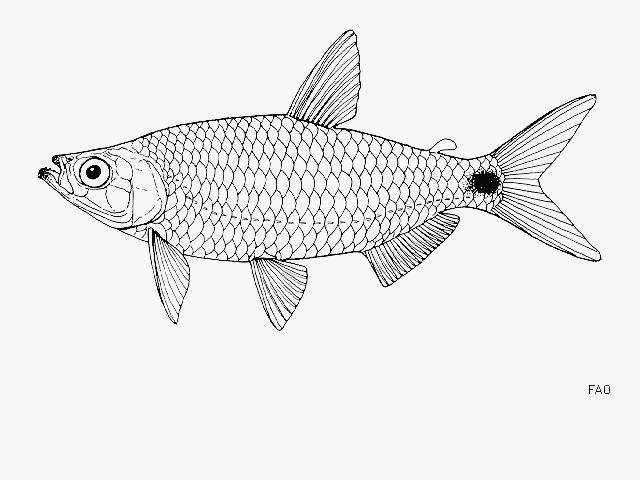|
Dorsal spines (total): 0-0; Dorsal soft rays (total): 10-10; Anal spines: 0-0; Anal soft rays: 21-23; Vertebrae: 36-37. Diagnosis: This species is diagnosed by a unique cuspidation pattern of the inner row premaxillary dentition with the cusps of the cutting-edge oriented buccally, vs. lingually oriented in all other alestids, and the possession of a distinctively shaped margin of the supraoccipital with a steep anterodorsal convexity at the junction of the parietals followed by a dorsomedial concavity on the surface of the supraoccipital (Ref. 127953). Description: Body moderately elongate, body height 3.1 times in standard length; dorsal head profile concave from snout to supraoccipital, convex to dorsal-fin origin, slightly convex along dorsal-fin base to adipose fin, and slightly concave from adipose fin to origin of caudal fin; ventral body profile convex from anterior tip of lower jaw to end of anal-fin base, slightly concave to caudal fin; caudal peduncle longer than deep (Ref. 42032, 127953). Head length 3.75 times in standard length (Ref. 42032). Adipose eyelid weakly developed, restricted to thin band immediately anterior to orbit; snout shorter than orbital diameter; nostrils closely aligned, anterior nostril circular, posterior nostril semi lunate (Ref. 127953). Lower jaw slightly prognathous, mouth superior, horizontally aligned with dorsal margin of pupil; teeth in both jaws pluricuspid and incisiform with reduced buccal shelves; dentary with 4 outer row teeth, median tooth frequently with five cusps, second and third teeth with seven cusps, fourth tooth markedly smaller than adjacent tooth; inner row of conical teeth proximate to dentary symphysis absent ; contralateral premaxillae separated by anteromedial process of mesethmoid and without interdigitations connecting medial surfaces; premaxilla with two rows of pluricuspid teeth; outer premaxillary row usually with 2 tricuspid teeth, but number variable (0, 1 or 3), even variable contralaterally; regardless of number, outer row premaxillary teeth always implanted above and between inner row teeth; inner premaxillary row with 4 teeth, each with 7 cusps; series of cutting-edge cusps of inner row premaxillary teeth located along buccal, vs. lingual, face of each tooth; four replacement teeth in both premaxillary and dentary replacement trenches; maxilla edentulous, ascending process elongate and pointed, without terminal bifurcation (Ref. 127953). Distal margin of dorsal fin straight, second unbranched and first branched fin rays longest; dorsal-fin rays ii,8, first unbranched ray very short; distal margin of pectoral fin straight or slightly rounded; adpressed pectoral fin reaching or surpassing pelvic-fin origin; pectoral-fin rays ii,13-15; pelvic fin pointed, adpressed pelvic fin reaching two to four scales short of anal-fin origin; pelvic-fin rays ii,7-10; caudal fin forked; adipose fin present, tall with narrow base; anal fin emarginate, anteriormost branched rays more than twice length of ultimate ray; anal-fin rays iii,18-20, first unbranched ray very short; vertical, dorsal and caudal fins not filamentous (Ref. 42032, 127953). Lateral line scales from supracleithrum to hypural joint 30-33; anteriormost 6 scales of lateral line descending steeply to below midlateral line; last 3-4 pored scales slightly ascending to midlateral body plane; scales posterior to hypural joint 2 or 3; scales in transverse series from lateral line to dorsal-fin origin 6.5 or 7.5; scales in transverse series from lateral line to pelvic-fin origin 2 or 2.5; middorsal series from supraoccipital tip to dorsal-fin origin 13-17; circumpeduncular scales 10 or 11; axial scale present, extending over basal third of pelvic fin (Ref. 127953). First gill arch with 11-12 epibranchial rakers and 18-23 rakers on ceratobranchial and hypobranchial arches (Ref. 127953). Total vertebrae 36 or 37; supraneurals 8, first supraneural associated with fourth vertebra (Ref. 127953). Colouration: In preservation, overall body colouration brownish yellow, darker dorsally than ventrally, often with overlay of silver iridescence; small, vertically elongated humeral blotch of pigmentation around fourth and fifth scale of midlateral surface of body, faint in most specimens but more evident in larger individuals; faint deep-lying longitudinal stripe along midlateral surface from supracleithrum to anterior margin of caudal peduncle; posterior region of caudal peduncle with blotch of dark pigmentation, circular to ovoid in shape extending to proximal margin of middle caudal-fin rays; distal caudal-fin lobes with dark margins; adipose fin outlined by small dark chromatophores, more so on dorsal margin (Ref. 127953). In life overall body colouration iridescent silver, darker dorsally; humeral and caudal blotch visible but overlain by silver iridescence; dorsal, caudal, and anal fins yellowish to dark orange, distal margin of caudal fin darker; adipose fin yellowish; pectoral and pelvic fins hyaline; first unbranched pectoral-fin ray slightly darker (Ref. 127953). |

